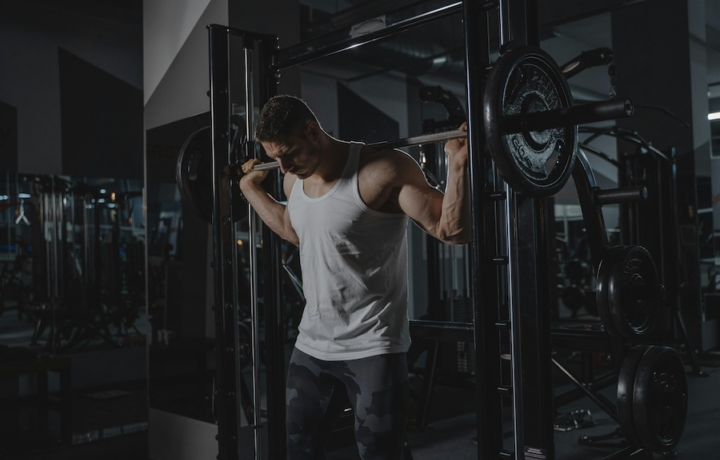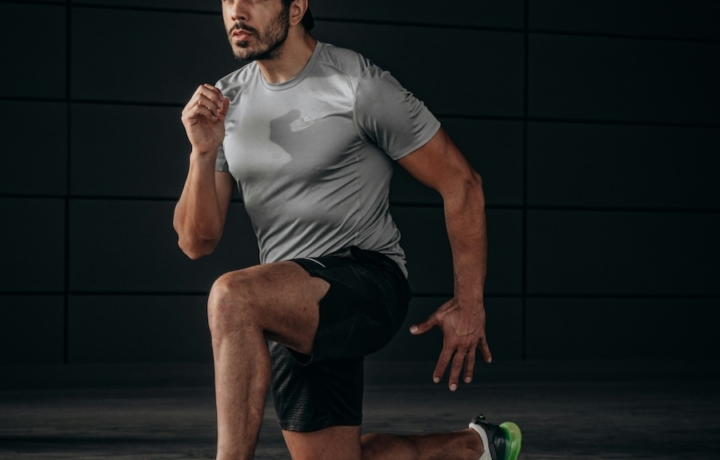Exercise
Sumo Squat Floor Touch

Sumo Squat Floor Touch
How to Perform
- Stand with your feet wider than shoulder-width apart, with toes pointed outward at a 45-degree angle.
- Engage your core and maintain a neutral spine as you hinge your hips back, keeping your chest up and shoulders retracted.
- Bend your knees to lower your body into a deep squat position, tracking your knees in line with your toes.
- As you descend, exhale and reach both hands down toward the floor between your feet, maintaining a flat back.
- Touch the floor lightly with both hands while keeping your weight in your heels and midfoot.
- Inhale as you drive through your heels and engage your glutes to return to the starting position.
- As you rise, bring your arms back to your sides, keeping your chest lifted and spine neutral throughout the movement.
- Fully extend your hips and knees at the top position before beginning your next repetition.
Important information
- Keep your back flat throughout the movement—avoid rounding your spine when reaching for the floor.
- Make sure your knees track in the same direction as your toes to prevent knee strain.
- If you can't touch the floor comfortably, only go as low as your mobility allows or touch your shins instead.
- Maintain tension in your core throughout the exercise to protect your lower back.

Sumo Squat Floor Touch
Exercise Details
Primary Muscles
Muscle Groups
Mechanic
Risk Areas
Built for progress
Take the guesswork out of training
Create personalized AI-powered workout plans that evolve with you. Train smarter, track every rep and keep moving forward, one workout at a time.






The Sumo Squat Floor Touch offers a dynamic challenge that takes the traditional sumo squat to the next level by incorporating a mobility element that demands both strength and flexibility. This intermediate movement primarily targets the glutes, quads, and hamstrings while engaging your core stability throughout the full range of motion.
What makes this exercise particularly valuable for bodybuilding enthusiasts is its ability to develop lower body musculature with a greater emphasis on inner thigh activation compared to conventional squats. The wide stance naturally recruits more of the adductor muscles while still maintaining substantial tension on the primary movers. For those incorporating HIIT workouts into their routine, the Sumo Squat Floor Touch serves as an excellent compound movement that elevates heart rate while building functional lower body power.
The dual focus on strength and mobility makes this exercise especially beneficial for athletes looking to improve performance. The strength component comes from the demanding squat position in a wide stance, requiring significant muscular engagement to maintain proper form. Meanwhile, the floor touch element enhances hip mobility and encourages greater range of motion in the ankles, hips, and thoracic spine – areas where many people experience limitations that can hinder athletic performance and daily movement quality.
As you progress with this exercise, you'll likely notice improvements in hip flexibility and lower body control that transfer to other activities. The wide stance creates a stable base that allows for developing better proprioception and body awareness, particularly valuable for those involved in sports requiring lateral movement patterns. The floor touch aspect adds a coordination challenge that develops mind-muscle connection beyond what simpler exercises provide.
When incorporated regularly into your training regimen, the Sumo Squat Floor Touch can become a cornerstone movement that bridges the gap between pure strength work and mobility training, offering comprehensive lower body development in a time-efficient manner.
FAQ - Sumo Squat Floor Touch
The Sumo Squat Floor Touch primarily targets the quadriceps, hamstrings, and glutes while significantly engaging the inner thighs (adductors) due to the wide stance position. Your core muscles are also heavily activated throughout the movement to maintain stability, especially during the floor touch portion.
The most common mistakes include allowing the knees to collapse inward, rounding the lower back during the floor touch, and not maintaining proper weight distribution through the heels and midfoot. Always keep your chest up, knees tracking over toes, and maintain a neutral spine even at the bottom of the movement.
If you're a beginner, start with a regular sumo squat without the floor touch, or only go down as far as your mobility allows. You can also elevate the touch target by using a yoga block or small platform instead of reaching all the way to the floor, gradually working toward greater depth as flexibility improves.
Incorporate this exercise 2-3 times weekly with at least one day of recovery between sessions to allow your lower body muscles to recover properly. This exercise works well as part of a leg day routine or as a compound movement in a full-body workout, typically performing 3-4 sets of 10-15 repetitions.
To increase difficulty, add resistance with dumbbells or kettlebells held at your sides, incorporate a pulse at the bottom position, or increase time under tension by slowing the eccentric (lowering) phase to 3-4 seconds. For an advanced challenge, perform the movement on an unstable surface or add a jump as you return to the standing position.









